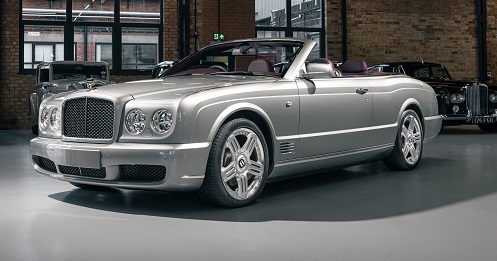

Convertible, 2 Doors, 4 Seats
19.5 l/100 km 12.06 US mpg
28.8 l/100 km 8.17 US mpg
14.1 l/100 km 16.68 US mpg
457 Hp @ 4100 rpm.
67.7 Hp/l
270 km/h 167.77 mph
6750 cm3
411.91 cu. in.
8, V-engine
Rear wheel drive,
5400 mm
212.6 in.
1910 mm
75.2 in.
2695 kg
5941.46 lbs.
| Brand | Bentley |
|---|---|
| Model | Azure (Convertible) |
| Version | Azure II |
| Engine version | 6.7 i V8 (457 Hp) Automatic |
| Year production start | 2005 |
| Year production end | 2009 |
| Vehicle type | Convertible |
| Horsepower RPM | 457 Hp @ 4100 rpm. |
| Acceleration 0 - 100 kmh sec | 6 sec |
| Curb weight kg -lbs total |
2695 kg5941.46 lbs. |
| Overall length mm - inch |
5400 mm212.6 in. |
| Doors | 2 |
| Top Speed | 270 km/h 167.77 mph |
| Designation model | BFA |
|---|---|
| Cam configuration | OHC |
| Engine position and orientation | Front, Longitudinal |
| Cylinders | 8 |
| Position of cylinders | V-engine |
| Displacement (liters) |
6750 cm3411.91 cu. in. |
| Eng. horsepower RPM | 457 Hp @ 4100 rpm. |
| Horsepower per litre | 67.7 Hp/l |
| Weight / horsepower kg/hp - hp/tons |
5.9 kg/Hp169.6 Hp/tonne |
| Weight / torque kg/Nm - Nm/tons | 3.1 kg/Nm, 324.7 Nm/tonne
3.1 kg/Nm324.7 Nm/tonne |
| Torque Nm RPM lb-ft RPM |
875 Nm @ 3250 rpm.645.37 lb.-ft. @ 3250 rpm. |
| Bore (mm in) |
104.1 mm4.1 in. |
| Stroke (mm in) |
99.01 mm3.9 in. |
| Compression ratio | 7.8 |
| Fuel delivery system | Multi-point indirect injection |
| Fuel type | Petrol (Gasoline) |
| Valvetrain | 2 |
| Engine aspiration | Turbocharger, Intercooler |
| Engine oil liters | quarts |
9 l9.51 US qt | 7.92 UK qt |
| Engine coolant |
20 l21.13 US qt | 17.6 UK qt |
| Powertrain architecture | Internal Combustion engine |
| Engine location | Front, Longitudinal |
| Drive configuration | Rear wheel drive |
|---|
| Front brakes | Ventilated discs |
|---|---|
| Rear brakes | Ventilated discs |
| Brake control | Ventilated discs |
| Anti-lock brake system | ABS (Anti-lock braking system) |
| Front suspension | Spring Strut |
|---|---|
| Rear suspension | Helical spring |
| Wheels size | 255/45 R19 |
|---|---|
| Wheels rims | 8J X 19 |
| Passengers seats | 4 |
|---|
| Overall length mm - inch |
5400 mm212.6 in. |
|---|---|
| Overall width mm -inch |
1910 mm75.2 in. |
| Overall height mm -inch |
1485 mm58.46 in. |
| Wheelbase mm - inch |
3116 mm122.68 in. |
| Track width front mm - inch |
1602 mm63.07 in. |
| Track width rear mm - inch |
1602 mm63.07 in. |
| Curb weight kg -lbs total |
2695 kg5941.46 lbs. |
|---|---|
| Gross weight kg -lbs total |
3065 kg6757.17 lbs. |
| Capacities kg - lbs |
370 kg815.71 lbs. |
| Fuel tank liters | gallons |
100 l26.42 US gal | 22 UK gal |
| City l/100km - mpg |
28.8 l/100 km8.17 US mpg |
|---|---|
| Highway l/100 km - mpg |
14.1 l/100 km16.68 US mpg |
| Combined l/100 km - Mpg |
19.5 l/100 km12.06 US mpg |
| Autonomy km (combined use) | 526 |
8 CYLINDER V-Engine
It's an engine with eight cylinder piston where the cylinders share a common crankshaft and are arranged in a V configuration.
What is the 8 cylinder V-engine displacement: it is in a range between 2926 cc and 8135 cc in recent model line up powertrain.
How much is the power of the 8 cylinder V-engine: the power of the 8 cylinder V-engine is in a range from 125 bhp to 1160 bhp.
Which cars use 8 cylinder V-engine: in recent years several manufactures have been used the V8 engine for 3 main applications: premium, sport cars and lightweight trucks. 8 V engine is the American preferred engine for iconic giant pick-up.
What is the eight cylinder V angle: the majority of V8 engines use a V-angle of 90 degrees. This angle results in good engine balance and low vibrations. The downside is a larger powertrain body that makes the use of this configuration suitable only for longitudinal position and rear drive wheels traction.
V8 engines with a 60 degree V-angle were used in the 1996-1999 by Ford and in 2005-2011 by Volvo. The Ford engine used a 60 degree V-angle because it was based on a V6 engine with a 60 degree V-angle. Both the Ford and Volvo engines were used in transverse engine chassis, which were designed for a front-wheel-drive layout. To reduce the vibrations caused by the unbalanced 60 degree V-angle, Volvo's used a balance shaft and offset split crankpins.
The Rolls-Royce Meteorite tank engine also used a 60 degree V-angle, since it was derived from the 60 degree V12 Rolls-Royce Meteor which in turn was based on the famous Rolls-Royce Merlin V12 engine.
Most V8 engines fitted to road cars use a cross-plane crankshaft, since this configuration produces less vibration due to the perfect primary balance and secondary balance.
The rumbling exhaust sound produced by a typical cross-plane V8 engine is partly due to the uneven firing order within each of the two banks of four cylinders and with separate exhaust systems for each bank of cylinders, this uneven pulsing creates the legendary rumbling sound that is typically of V8 engines.
edited by arrabbiata